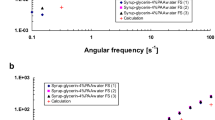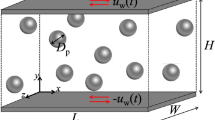Abstract
Particle-level simulations are employed to investigate the transition from linear to nonlinear rheological behavior for electrorheological suspensions under start-up of steady shear flow. This transition is found to first arise from the very slight rearrangement of structures, as opposed to the gross rupture of particulate columns. Linear stability analysis shows that these rearrangements occur when the structures are sheared into electrostatically unstable configurations. The rearrangements also produce a second type of relaxation phenomenon that appears at low frequencies and finite strain amplitudes. Incorporating more realistic force descriptions into the idealized simulation model shifts the transition to nonlinear deformation to smaller strain amplitudes, approaching experimentally observed values. The role of the rearrangement of unstable structures on the oscillatory shear flow response is investigated in the following paper, Part II.
Similar content being viewed by others
References
Allen MP, Tildesley DJ (1991) Computer simulations of liquids. Oxford University Press, New York
Bailey P, Gillies DG, Heyes DM, Sutcliffe LH (1989) Experimental and simulations studies of electro-rheology. Mol Sim 4:137–151
Bonnecaze RT, Brady JF (1992) Dynamic simulations of an electrorheological fluid. J Chem Phys 96:2183–2202
Clercx HJH, Bossis G (1993) Many-body electrostatic interactions in electrorheological fluids. Phys Rev E 48: 2721–2738
Dukhin SS (1970) Dielectric properties of disperse systems. J Surf Coll Sci 3:83–165
Gamota DR, Wineman AS, Filisko FE (1993) Fourier transform analysis: Nonlinear dynamic response of an electrorheological material. J Rheol 37:919–933
Ginder GM, Davis LC (1993) Viscoelasticity of electrorheological fluids: Role of electrostatic interactions. Presented at the Fourth International Conference on Electrorheological Fluids, Feldkirch, Austria, July 20–23
Hass KC (1993) Computer simulations of non-equilibrium structure formation in electrorheological fluids. Phys Rev E 47:3362–3373
Jordan TC, Shaw MT, McLeish TCB (1992) Viscoelastic response of electrorheological fluids. II. Field strength and strain dependence. J Rheol 36:441–463
Klingenberg DJ, van Swol F, Zukoski CF (1989) Dynamic simulation of electrorheological suspensions. J Chem Phys 91:7888–7895
Klingenberg DJ, Zukoski CF (1990) Studies on the steady-state behavior of electrorheological suspensions. Langmuir 6:15–24
Klingenberg DJ, van Swol F, Zukoski CF (1991a) The small shear rate response of electrorheological suspensions: I. Simulation in the point-dipole limit. J Chem Phys 94:6160–6169
Klingenberg DJ, van Swol F, Zukoski CF (1991b) The small shear rate response of electrorheological suspensions: II. Extension beyond the point-dipole limit. J Chem Phys 94:6170–6178
Klingenberg DJ (1993) Simulation of the dynamic oscillatory response of electrorheological suspensions: demonstration of a relaxation mechanism. J Rheol 37:199–214
Marshall L, Goodwin JW, Zukoski CF (1989) Effect of electric fields on the theology of nonaqueous concentrated suspensions. J Chem Soc Faraday Trans I 85:2785–2795
McLeish TCB, Jordan T, Shaw MT (1991) Viscoelastic response of electrorheological fluids. I. Frequency dependence. J Rheol 35:427–448
Melrose JR (1992) Brownian dynamics simulation of dipole suspensions under shear: the phase diagram. Mol Phys 76:635–660
Otsubo Y (1991) Electrorheological properties of barium titanate suspensions under oscillatory shear. Coll and Surf 58:73–86
Otsubo Y, Sekine M, Katayama S (1992) Electrorheological properties of silica suspensions. J Rheol 36:479–496
Parthasarathy M, Alm KH, Belongia B, Klingenberg DJ (1994) The role of suspension structure in the dynamic response of electrorheological suspensions. Int J of Mod Phys B 8:2789–2809
Parthasarathy M, Klingenberg DJ (1995b) A microstructural investigation of the nonlinear response of electrorheological suspensions: II. Oscillatory shear flow. Submitted to Rheol Acta
Press WH, Teukolsky SA, Vetterling WT, Flannery BP (1992) Numerical recipes in FORTRAN: the art of scientific computing. Cambridge University Press, Cambridge
Russel WB, Saville DA, Schowalter WR (1989) Colloidal Dispersions. Cambridge University Press, Cambridge
See H, Doi M (1992) Shear resistance of electrorheological fluids under time-varying electric fields. J Rheol 36:1143–1163
Shulman ZP, Korobko EV, Yanovskii YG (1989) The mechanism of the viscoelastic behaviour of electrorheological suspensions. J Non-Newt Fluid Mech 33:181–196
Whittle M (1990) Computer simulation of an electrorheological fluid. J Non-Newt Fluid Mech 37:233–263
Winslow WM (1949) Induced fibration of suspensions. J Appl Phys 20:1137–1140
Yen WS, Achorn PJ (1991) A study of the dynamic behavior of an electrorheological fluid. J Rheol 35:1375–1384
Author information
Authors and Affiliations
Rights and permissions
About this article
Cite this article
Parthasarathy, M., Klingenberg, D.J. A microstructural investigation of the nonlinear response of electrorheological suspensions. Rheola Acta 34, 417–429 (1995). https://doi.org/10.1007/BF00396555
Received:
Accepted:
Issue Date:
DOI: https://doi.org/10.1007/BF00396555




